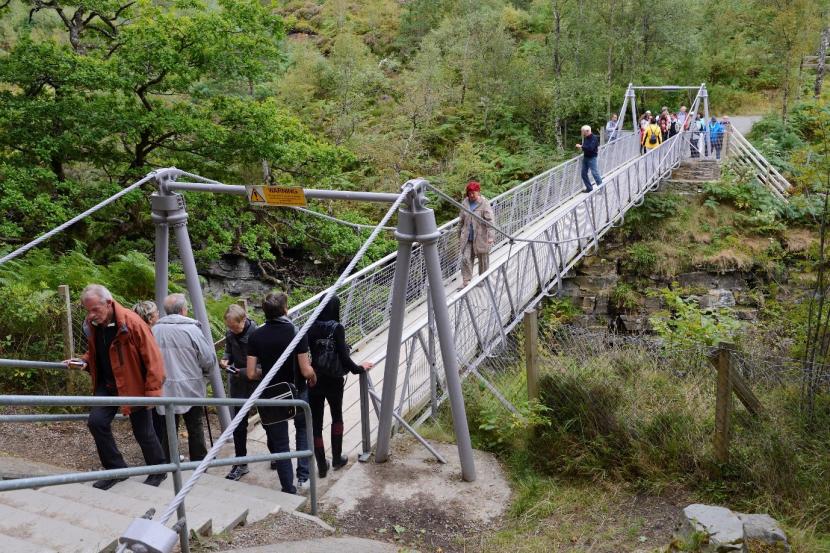
Feast your eyes on this Gorge
13 July 2021
Leugh ann an Gàidhlig (read in Gaelic)
Over 60 metres deep, around 1.5km long, and spanned by a spectacular suspension bridge, Corrieshalloch Gorge makes a big impact. That’s set to continue with a new visitor centre and improved path network taking shape at this famous Wester Ross site.
Corrieshalloch, which is managed by The National Trust for Scotland, is the smallest of Scotland’s National Nature Reserves, but what it lacks in size it more than compensates for in visual drama. The dizzying 25m suspension bridge high over the glistening River Droma dates back to 1874 and has steadily drawn visitors since Victorian times. It remains one of the ‘must see’ sights in Wester Ross.

With support from the Natural and Cultural Heritage Fund the team at Corrieshalloch Gorge plan to launch a stunning ‘Gateway to Nature’ here. This will see a new visitor centre, improved and expanded car parking (which will include provision for electric vehicles and campervans), fresh interpretation, and the creation of new path networks with clear wayfinding and signage. It’s an exciting new milestone in the site’s history. The National Trust for Scotland’s General Manager the Highlands and Islands, Clea Warner, is understandably enthusiastic about the benefits the new funding will bring. “These new facilities will be the gateway to the rich natural heritage of the Gorge and the Falls of Measach, one of the most spectacular waterfalls in the UK,” she explains, “and will make a major contribution to the local area, vastly improving the welcome we can offer the increasing number of visitors who are heading north.”

Being on the route of the North Coast 500 has brought both popularity and pressures to this fascinating site, as Clea appreciates “As a National Nature Reserve, Corrieshalloch Gorge requires intensive protection. These new facilities will help us to accommodate the growing number of visitors, while ensuring the site gets the important conservation care that a place of such importance needs.”
There is of course a lot to see here. The gorge is famed for its mosses and liverworts, and Britain’s smallest fern – Wilson’s filmy fern. Far easier to see are the ravens which have been known to nest on a ledge near the suspension bridge.
No matter what season there is plenty of natural interest at Corrieshalloch. In spring an array of wildflowers catch the eye, and even in the deepest, shady depths of the gorge plants including mountain sorrel, germander speedwell and saxifrage thrive.
Fast-forward to summer and the sound of woodland birds fills the gorge. Tourism numbers soar and the views into the ravine captivate young and old alike.
In autumn the rich colours of a range of native trees including birch, rowan, oak, hazel, elm and pine provide a sensational backdrop. If your luck is in you might even catch a glimpse of that most popular of mammals, the dashing red squirrel.
Yet, for all the natural lure of the site, a major attraction at the reserve remains the B-listed suspension bridge at the stunning Falls of Measach. It has been through a few overhauls since John Fowler built it, but remains an enduring attraction, and that’s little surprise as Fowler was a visionary who earned fame as the lead engineer on the Forth Railway Bridge. Much of his planning for bigger projects was carried out at his Braemore Estate just north of Corrieshalloch.
Let’s end with a quirky thought. Things aren’t always as straightforward as they appear. Whilst Corrieshalloch Gorge NR is indeed the smallest National Nature Reserve in Scotland at 6.9 ha (and has held that claim to fame since 2003) there is an interesting debate to be had over measuring size. Corrieshalloch Gorge’s surface area is probably significantly greater because of the steep sides of the deep box canyon.
However, by any measure Corrieshalloch Gorge is a Scottish success story. The new facilities will surely see that continue long into the future.

About The Natural and Cultural Heritage Fund
The Natural and Cultural Heritage Fund is funded through the European Regional Development Fund (ERDF) with a multi £million investment in the Highlands and Islands. The purpose of the Fund is to promote and develop the outstanding natural and cultural heritage of the Highlands and Islands in a way that conserves and protects them.
The Natural & Cultural Heritage Fund is part of the Scottish Government’s current European Regional Development Fund (ERDF) programme, which runs through to 2023. This is one of two ERDF Strategic Interventions led by NatureScot – the other is the Green Infrastructure Fund.
You can follow the European Structural Funds blog for ESF activities, news and updates. For twitter updates go to @scotgovESIF or use the hashtags #ERDF and #europeanstructuralfunds



